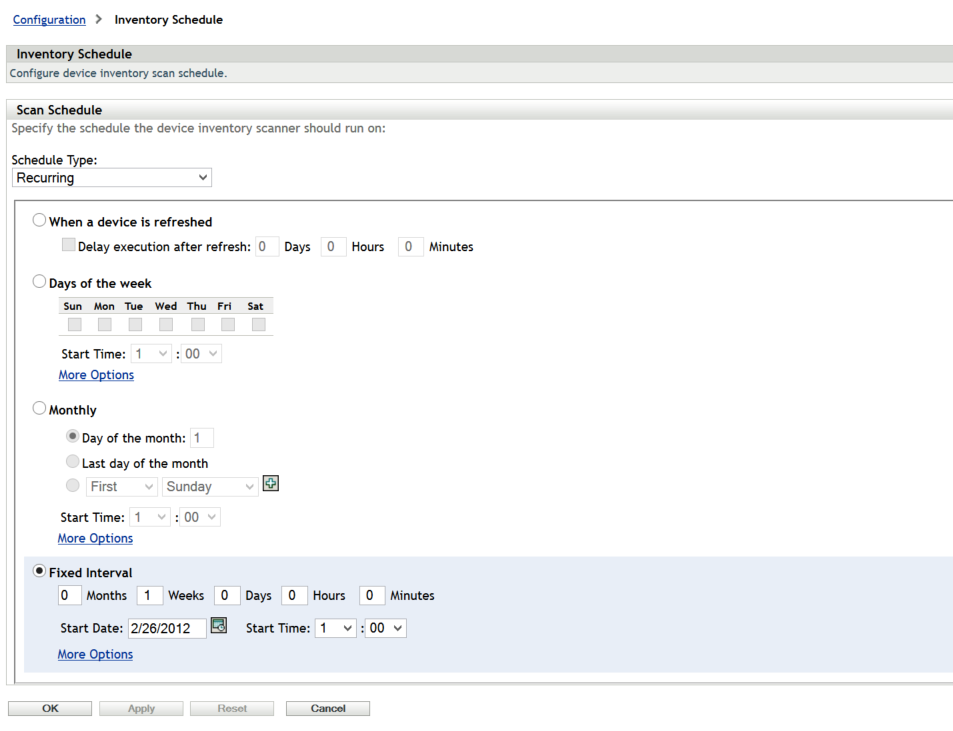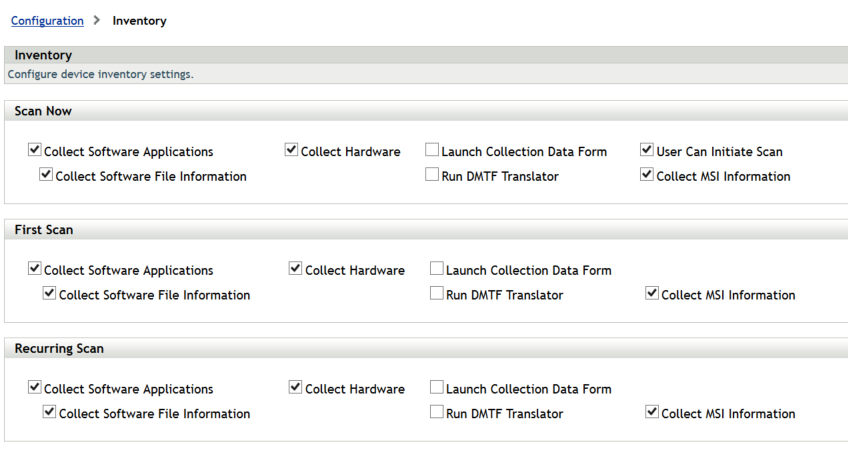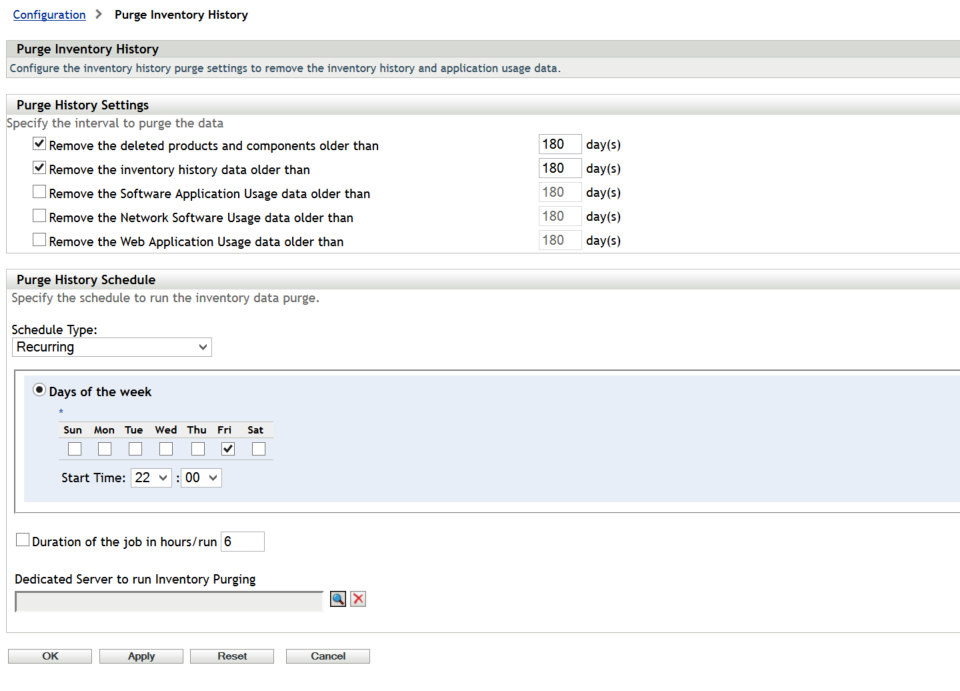3.7 Inventory
ZENworks contains a powerful feature for collection and reporting on software and hardware inventory in the environment. The configuration of the inventory collection should be managed before deployment to ensure that the devices are collecting only relevant information.
3.7.1 Inventory Settings and Scheduling
Inventory collection settings are split into three main sections. Each section is configured independent of the other.
-
Scan Now: For devices that are manually forced to perform inventory scans.
-
First Scan: For scans that need to be performed on agents that are installed for the first time. This scan is controlled by the Logins before first scan configuration settings in ZENworks Control Center. This setting should complement the build process of the devices.
-
Recurring Scan: This scan is controlled by the Inventory Scan Schedule. For more information, see
Scheduling an Inventory Scan
in the ZENworks Asset Inventory Reference.
Inventory scan frequency depends on how often the hardware and software in the environment change, and how accurate the information needs to be. Under normal circumstances, it should be adequate to collect inventory data on a weekly, biweekly, or monthly basis, but this might not be sufficient for all deployments. Be aware of the workload placed on the ZENworks Primary Servers. Every inventory scan a device does must be processed by the ZENworks Primary Server and stored in the ZENworks database. Ensure that the schedule does not unnecessarily scan thousands of devices on a daily basis, but if this is necessary, closely monitor the load and performance of both the Primary and database servers. Inventory schedules can be set at the Management Zone folder, and device level. We recommend that you configure inventory schedules on a folder basis to ensure that the load is spread through a given time period. If you must immediately update the inventory of a device, a scan-now request can be sent to the device via ZENworks Control Center.
For a weekly scan, select a day that is most likely to capture the largest number of devices connected to the network. To capture all workers, consider performing a scan on every fifth day so that all days are eventually targeted.
For restricted scan times use the random wait time carefully. If a scan window of 9:00–17:00 is configured with the Randomize scan time option, devices that disconnect during this period might not be scanned. This can cause many devices to consistently miss their scans. The Process immediately if device unable to execute on schedule option instructs any device that missed the schedule to scan when it next connects to ZENworks. This is useful for ensuring that devices perform an inventory when they are offline during their assigned inventory schedule.
Use a schedule that best fits the environment and avoid restricting the scan times severely. A very small scan potential window can lead to many devices not performing regular inventory scans.
If some devices are always on, consider starting the scan schedule before or after normal office hours, so these devices can be processed when there is low utilization.
We recommend using a combination of inventory reporting and the advanced device search function to compare last scan dates with last contact dates, so you can ensure that devices are being scanned according to their schedules.

During inventory processing, if frequent deadlock occurs, we recommend that you perform the following to prevent the locking:
Modify the <Parameter Name="enableDistributedLocking">false</Parameter> parameter value to true in the inventorystorer.xml file and then restart the Micro Focus ZENworks Loader service. The inventorystorer.xml is available in the following location:
Windows: %ZENSERVER_HOME%\conf\loader
Linux: /etc/opt/microfocus/zenworks/loader
3.7.2 Software File Information
Select the Collect Software File Information option only if you must identify software products that are not recognized by the ZENworks Knowledge base. This option forces a very granular collection of inventory information, which has performance impacts throughout the ZENworks infrastructure. If you must create local software products based on software file information, we recommend that you override inventory settings only on the individual target devices.

For more information, see the ZENworks Asset Inventory Reference.
3.7.3 Collection Data Form and Collection Data Form Scheduling
The collection data form is used to collect demographic information for a device or user. The information can be collected on several schedules or events, or it can be collected manually. You can also use the Scan Now, First Scan, or Recurring Scan options. This information can be very useful when attempting to identify where devices are located and who is using them.
Select a schedule that best fits your requirements. Collecting this information on a monthly basis should be a good choice. Ensure that you run a new collection after a change, such as a move or a user change.
Use the auto-fill function to avoid user input. System variables and registry settings can be used to silently collect the demographic data. These variables or settings can be delivered through the install process or through bundles. Administrator-defined fields should be created to collect additional information.
For more information, see the ZENworks Asset Inventory Reference.
3.7.4 Inventory Pruning
As data is collected, information about hardware and software that has been added or removed from devices is stored as historical change data. Depending on the frequency of updates, and frequency of scans, this can generate a large amount of data that is purely historical. While this data may be important to your organization, you should ensure that only an appropriate amount of data is being maintained to meet the needs of your organization. ZENworks provides an option to configure how much of this historical data is kept and when the data is cleaned up.We recommend that you set the values to meet these needs, but setting the Purge Inventory History setting shown below:

3.7.5 Inventory Loader Thread Configuration
The loader module responsible for reading the inventory results and storing them in the database is multi threaded. This means that each server can now store many inventory scans simultaneously instead of serially. Depending on your server hardware, the number of devices being scanned, and the frequency of the scan, you might choose to modify the default loader threads allocated for storing inventory.
To configure the Inventory Loader Thread:
Linux: Edit the /etc/opt/microfocus/zenworks/loader/inventorystorer.xml file and change the InventoryStorerThreadPoolSize parameter value from 10 to desired value.
Windows: Edit the %ZENSERVER_HOME%\conf\loader\inventorystorer.xml file and change the InventoryStorerThreadPoolSize parameter value from 10 to desired value.
To arrive at inventory thread numbers there is no exact formula. During the peak inventory schedule, you need to observe how may WIF files are getting uploaded and how much time its taking to process them. If the processing rate is slow you can increase the thread count by a small amount, for example, 10. Then observe the processing rate. If its still not up to the mark, you can increase the number further and repeat the exercise till you arrive at a satisfactory number. During this process, if the server gets slow or un-responsive, you should not increase the number further. Instead, reduce the number so that the server runs smoothly. If the WIF processing rate is still not satisfactory, then, add a new collection server.